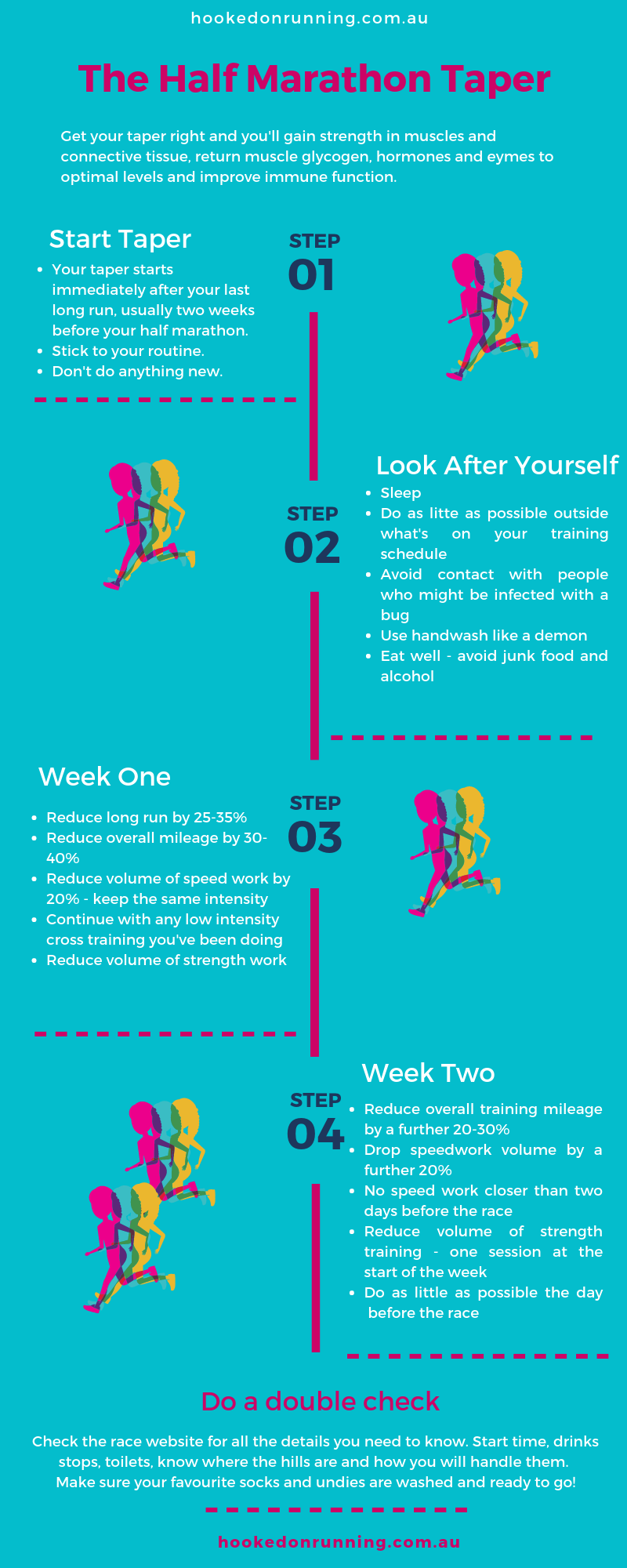
What is half marathon tapering?
Tapering for a half marathon means cutting back on your training so that you can be in peak physical fitness for the race. During the taper period you should stick to your usual training routine, but reduce the volume of running you do in each training session. Tapering is one of the most important aspects of any half marathon or marathon training plan, but it can be one that gets the least attention.
It can also be hardest to implement, since most runners like to well… run, and find it hard to cut back just as their big race looms.
Don’t expect to feel good after just a few days of easy running. It could take up to 10 days before you fully recover from your last hard workout, so you may feel a bit sluggish right up till a couple of days before the race.
Why you should taper for your next half marathon?
- Training adaptations happen when your body is in recovery. You work hard and stress your body, a small amount of damage happens, the body repairs itself and comes back stronger ready for the next onslaught! It can’t repair itself if you don’t give it some downtime. During the taper period, you can gain strength in your muscles and connective tissue.
- In periods of high training, levels of muscle glycogen, antioxidants, hormones and enzymes become depleted. The tapering period is a time for these to all return to optimal levels.
- You won’t so much get fitter during the taper period as re-energise and allow your body to build itself back up to be stronger than it was when you were putting yourself through all that heavy training.
- Your immune function also improves as you drop your training volume
If tapering improves my immune function, why do I get sick during my taper period?
When you’re in heavy training, your immunity can be reduced. Heavy training sessions of more than 90 minutes can make you more susceptible to picking up a bug for up to 72 hours after your workout. So when you’re working out a lot, you’re quite susceptible to picking something up.
The reason for this seems to be that during heavy workouts, the body produces hormones which temporarily lower immunity. You produce more of the stress hormones cortisol and adrenaline. These hormones raise blood pressure, raise cholesterol levels and suppress the immune system.
The last training session you do before you begin your half marathon taper will be a pretty long run. If you’re an experienced runner, that long run might include some speed surges, hill efforts or a fast finish. Whatever it is you do in that session, it’s more than likely going to be up there as one of the harder sessions of your training block. You will, therefore, be susceptible to getting sick for 3 days after this training session.
The incubation period for a cold is between one and three days, and for the flu one and four days. So, if you’re exposed to some nasty little viral bugs 3 days after your last long run when your immune system is still suppressed, and it takes another 3 days for those bugs to do their stuff, 6 days into your taper is about the right time get sick. Yes. One week out from your half marathon, and you have a cold.
It’s vitally important to look after yourself during the half marathon tapering period.
- Get plenty of sleep.
- Rest-try to reduce the amount of extra stuff you do. Try to organise for your kids to be off your hands for a few hours, forget about the cleaning for a while. Ask someone else to step up to the plate for you in this really important time.
- Eat well. Include fruit and vegetables in your diet, along with whole grains. Good quality food – no junk.
- Use hand wash, use it liberally, and use it often.
- Stay away from people who you might catch a cold from. I’ve known people to keep their kids out of daycare during a taper period to reduce the chance of catching a bug from them. Stay out of crowded areas. Try not to be near people on public transport. Use handwash after you get off the train or bus.
What’s the Best Way to Tackle Half Marathon Tapering?
Tapering is a highly personalised part of your training plan. The best half marathon taper for you, is one that you’ve worked out through trial and error over many races. Some people respond well to dropping back their mileage dramatically, others go better on a higher volume in their taper. The best way to figure out what works well for you is to meticulously record your training, year round. Good training notes will include what you did in each training session and how you felt, and of course, your race day results. Include your km splits and what went on in the race for you. Do it soon after your race before you have time to forget how you felt. Keeping detailed records of your taper periods and how you feel on race day will give you a good amount of information to look back on and work out what’s worked best for you.
With the help of a running coach, you can get great results from your taper. A coach will have been through the taper phase with many athletes and will have a good knowledge of what is likely to work for you.
But, if you’re going it alone, there are a few tips for you here.
Half Marathon Tapering Guidelines
Rule #1: Don’t do anything new during your taper. Do less of what you are already doing
Rule #2: Don’t do anything new during your taper. Do less of what you are already doing.
Yep. It’s important. Don’t suddenly start doing stuff you’ve never done before. If yoga hasn’t been part of your regular training, don’t start it now. If you don’t know how your tired body will react to massage, do not have a massage in race week. Don’t eat new foods, go to bed two hours earlier (or later), or decide it’s a good time to get in a spot of gardening!
Race Taper Week One
- Start your taper the day after your longest long run. This will generally be two weeks before race day.
- Reduce your overall mileage by 30-40% in the first week of your taper.
- The bulk of the reduction in your mileage will come from reducing the length of your long run. Reduce your long run by around 25-35%. If you opt for closer to a 25% reduction in duration, reduce the load more by running over flat terrain.
- Stick to the same routine. If you’re used to running 5 times a week, stick to running 5 times a week. The exception to this is if you have any niggles that you need to take care of. If that’s the case, you might need to drop one of your training sessions.
- Keep up with any speed work you’ve been doing. Keep the intensity the same, but drop the volume by around 20% in the first week of your taper. .
Race Taper Week Two
- Reduce your overall training mileage by a further 20-30% leading into race day.
- Your race will obviously take the place of one of your training sessions, and you shouldn’t run at all the day before your race. You therefore might not have enough days in the week to stick to your previous routine, so you can drop a mid-week session or two if you need to. If you’ve only been doing a couple of mid week runs regularly, you should be able to keep them in your schedule.
- Drop the volume of your speed work in the second week by another 20% or so. You should keep the same intensity that you have previously been working out at.
- Your last speed workout should be no closer than three days before your race.
- Rest the day before the race. Do as little as possible. Some coaches like people to have an easy run the day before the race, but I prefer a complete rest day to aid with carbohydrate loading.
It’s a fine line between dropping the volume enough to freshen up, and dropping it too much. Remember, you’re likely to still feel a little sluggish up to a few days before the race, so if you’ve already reduced your volume substantially, you should hang tight, be patient, and trust the process, rather than dropping your training further. This is why it’s important to keep notes on what you do during your taper, and how it makes you feel, so you can use that information to help fine tune your taper for your next race.
Strength Training and Cross Training During the Half Marathon Taper?
I know I’ve said it before, but here it is again. Your taper week is not the time to introduce anything new. If you have already been doing some strength training or other forms of cross training such as swimming or cycling, you can continue with it at a reduced volume. But, don’t start swimming because someone else said it would be good for you!
Week One-cross training
- In the first week of your taper, you can continue with all your cross training. If your cross training is usually done at an easy intensity, keep doing what you’ve been doing. The exception to this would be if you’ve been doing a 4 hour bike ride every week, or a 2 hour ocean swim! No matter how easy these sessions might be, cut them back. No more than 90 minutes for any easy cross training session in the first week of your taper.
- If your cross training is of a higher intensity, drop the duration of the workout back by around 40%.
- You can keep up your strength training in week one, but drop the volume. Keep the same intensity, don’t up the weight you’re lifting because you’ve dropped the volume. You might want to look at doing say 2 sets of an exercise instead of 3, with the same number of reps and the same resistance you have been doing previously.
Week Two-cross training
- One reduced volume strength session at the beginning of the week – no closer than 4 days out from your race. If your legs aren’t feeling great, you should cut it out all together.
- You can do another reduced volume non-strength training session (such as swimming, cycling, pole dancing) at the beginning of the week. Best to keep it no more than 4 days out, and no more than 50% of the volume you had been doing in peak training. You can drop it altogether if you feel you still need to freshen up more.
What Else Should You Do During a Half Marathon Taper?
Take the opportunity to fine tune your race strategy. Be sure you know what you need to do, and try to stick to it. Plan your strategy based on how you’ve gone in your training, the terrain of the course, and what the weather will be like. If you’re heading for an unseasonally hot day, be prepared for a slower race.
Reflect on your training. Look back on your training log and know that you’ve done enough. Think back to some great training sessions or races, and remember how you felt. Take confidence from this.
You can also look back on some sessions that haven’t felt so great, but you pushed through to the end, regardless. You had the determination to stick that out, so you’ve got the race covered.
Read the race website from start to finish. Make sure you know what to expect on the route. Where the hills are, where the drink stations are, toilets. Make yourself a check list of everything you need to do to be ready for the race. Wash your favourite socks and undies, make sure your racing shoes are dry…
When you shouldn’t taper
When your training volume has been low
You’ll get the most benefit from tapering when your build up to a race has been fairly consistent. If you’ve missed a chunk of training, you might be better continuing to build up your training instead. If you simply haven’t done a lot of running, you’ve not got much to recover from. A long run the week before the race might be a good way to run yourself back into some form. This run could be the same distance as you did on the weekend two weeks prior to the race, and should be an easy effort.
When your preparation has been less than ideal, continuing to run through what otherwise might have been your taper period can help you gain a psychological advantage and gain confidence.
When the race is a training run for another event
If the half marathon is part of a training plan for another event, you’ll generally not taper. You might cut your training back a bit during race week. This is less to do with your performance in the race, and more to do with ensuring you’re not overloading yourself too much and risking injury.
Use this handy infographic for your next half marathon taper.





